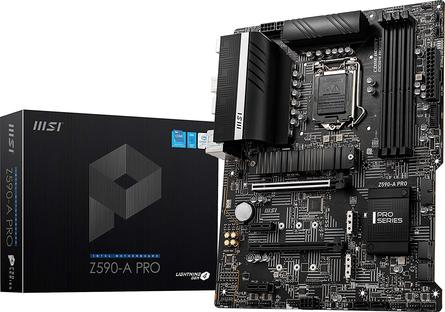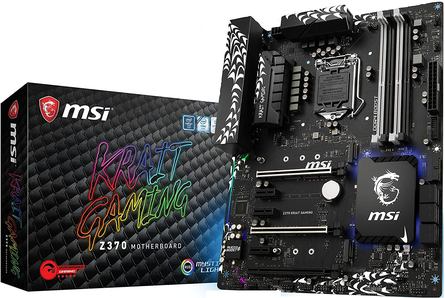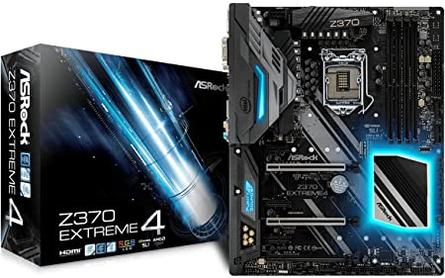The Intel Core i5-9600K remains a notable processor for builders focused on performance-per-dollar, especially in the used marketplace. As an unlocked 6-core CPU, it offers substantial gaming and productivity prowess, but unlocking its full potential hinges on selecting a capable and compatible motherboard. This guide provides a purely informational, technically grounded overview of the key motherboards associated with this CPU, helping you understand their features and suitability for a PC build or upgrade.
This analysis moves beyond simple recommendations to deliver an objective breakdown of specifications, capabilities, and crucial compatibility details. Whether you are building a new system from value-oriented parts or looking to upgrade your motherboard, this resource will equip you with the necessary information.
Understanding Motherboard Compatibility for the Intel i5-9600K
The Intel i5-9600K processor uses the LGA 1151 socket. However, not all LGA 1151 motherboards are compatible. The 9600K, being a 9th Generation CPU, requires a motherboard equipped with an Intel 300-series chipset.
The Z390 vs. Z370 Chipset: What’s the Difference?
The two primary enthusiast-grade chipsets compatible with the i5-9600K are the Z390 and the Z370. Understanding which function a motherboard’s chipset performs is key to making an informed choice.
- Intel Z390 Chipset: Launched alongside the 9th Gen CPUs, Z390 boards offer native, out-of-the-box support for the i5-9600K. They also integrate Intel Wireless-AC (Wi-Fi) and native USB 3.1 Gen 2 support directly into the chipset, features that Z370 boards required extra third-party controllers to provide.
- Intel Z370 Chipset: Originally designed for 8th Gen Intel CPUs, Z370 motherboards are also compatible with the i5-9600K. However, they almost always require a BIOS update to recognize the newer processor. Most second-hand Z370 boards will likely have an updated BIOS, but it’s a critical detail to verify before purchasing.
For any build, knowing how to update the motherboard BIOS is a valuable skill.
The Relevance of the i5-9600K in 2025
While newer CPUs offer more cores and higher efficiency, the i5-9600K maintains its standing as a strong budget option. Its key advantages are:
- Overclocking Headroom: When paired with a Z-series motherboard, the “K” designation means it can be overclocked, often reaching close to 5.0 GHz, which significantly boosts performance in applications that favor high clock speeds, such as many CPU-intensive games.
- Value: On the used market, the CPU and compatible motherboards can be acquired for a fraction of their original cost, enabling powerful 1080p and even 1440p gaming builds on a tight budget.
- Sufficient Core Count: For many gaming and general use cases, its six cores provide ample power to prevent bottlenecking with mid-range graphics cards like the RTX 3060 or a used RTX 2070.
Comparison of Top Motherboards for the i5-9600K
This table provides a high-level overview of the key specifications for the motherboards analyzed in this guide. Note that all of these models are officially discontinued but are widely available on the second-hand market.
| Feature | MSI Z590-A PRO | MSI Z390-A PRO | Gigabyte Z390 UD | ASUS ROG Maximus X Hero | ASRock Z370 Extreme4 |
| Status | Incompatible | Discontinued | Discontinued | Discontinued | Discontinued |
| Chipset | Intel Z590 | Intel Z390 | Intel Z390 | Intel Z370 | Intel Z370 |
| Socket | LGA 1200 | LGA 1151 | LGA 1151 | LGA 1151 | LGA 1151 |
| Form Factor | ATX | ATX | ATX | ATX | ATX |
| Memory Support | 4x DDR4, up to 5333MHz (OC) | 4x DDR4, up to 4400MHz (OC) | 4x DDR4, up to 4266MHz (OC) | 4x DDR4, up to 4133MHz (OC) | 4x DDR4, up to 4333MHz (OC) |
| VRM Phases | 14+2+1 | 9 (8+1) | 12 (10+2) | 10 (8+2) | 12 (Dr. MOS) |
| M.2 Slots | 1x PCIe 4.0, 2x PCIe 3.0 | 2x PCIe 3.0 x4 | 1x PCIe 3.0 x4 | 2x PCIe 3.0 x4 | 2x PCIe 3.0 x4 |
| SATA Ports | 6 | 6 | 6 | 6 | 8 |
| Primary PCIe Slot | PCIe 4.0 x16 | PCIe 3.0 x16 | PCIe 3.0 x16 | PCIe 3.0 x16 | PCIe 3.0 x16 |
| Ethernet | 1x Intel I225-V 2.5Gb | 1x Intel I219-V 1Gb | 1x Realtek 8118 1Gb | 1x Intel I219-V 1Gb | 1x Intel I219-V 1Gb |
| Audio Codec | Realtek ALC897 | Realtek ALC892 | Realtek ALC887 | ROG SupremeFX S1220 | Realtek ALC1220 |
| Rear USB (Total) | 8 | 6 | 8 | 8 | 7 |
In-Depth Analysis of i5-9600K Compatible Motherboards
Here we explore the specific features and positioning of each board. This objective analysis is designed to clarify which user each board is best suited for.
1. MSI Z590-A PRO

Important Compatibility Note
The MSI Z590-A PRO is not compatible with the Intel Core i5-9600K. This motherboard uses the LGA 1200 socket and the Z590 chipset, which are designed exclusively for 10th and 11th Generation Intel Core processors. Attempting to install an i5-9600K will not work and could potentially damage the components.
This board is included in this list to correct common misinformation and prevent a costly purchasing error. If you own a 10th or 11th Gen CPU, such as an i5-11600K or i9-10900K, this board is a viable option. For an i5-9600K, a Z390 or Z370 board is required.
Key Specifications
- Chipset: Intel Z590
- Socket: LGA 1200
- Form Factor: ATX
- Memory: 4x DDR4 slots, up to 128GB, 5333MHz (OC)
- Storage: 1x M.2 Gen4, 2x M.2 Gen3, 6x SATA 6Gb/s
- Power Delivery: 14+2+1 Duet Rail Power System
- Networking: Intel I225-V 2.5Gbps LAN
Analysis
As a board designed for a later generation, the Z590-A PRO features technologies not available on the Z390 platform, most notably PCIe 4.0 support when paired with an 11th Gen Intel CPU. This allows for faster NVMe SSDs and provides more bandwidth for next-generation graphics cards. Its 2.5Gbps LAN is also a significant step up from the 1Gbps standard on Z390 boards. The VRM solution is robust, designed to handle the higher power demands of 10th and 11th Gen i9 processors.
Objective Breakdown
- Pros: Modern features like PCIe 4.0 and 2.5Gbps LAN, strong power delivery system.
- Cons: Entirely incompatible with the i5-9600K.
Conclusion: A solid, feature-rich motherboard for its intended CPUs (10th/11th Gen Intel), but it should not be considered for an i5-9600K system. A correct alternative from MSI would be the MSI Z390-A PRO, detailed next.
2. MSI Z390-A PRO

Key Specifications
- Chipset: Intel Z390
- Socket: LGA 1151
- Form Factor: ATX
- Memory: 4x DDR4 slots, up to 128GB, 4400MHz (OC)
- Storage: 2x M.2 slots (PCIe 3.0 x4), 6x SATA 6Gb/s
- Power Delivery: 8+1 phase design
- Networking: Intel I219-V 1Gbps LAN
Analysis
The MSI Z390-A PRO was widely regarded as one of the best value-oriented Z390 motherboards. It provides a no-frills, performance-focused platform ideal for overclocking an i5-9600K without paying for premium features like extensive RGB or elaborate aesthetic shrouds.
Its 8+1 phase VRM is more than sufficient for pushing the 9600K to its limits, often achieving stable overclocks in the 4.8-5.0 GHz range, provided you maintain a normal CPU temperature while gaming. The inclusion of two M.2 slots and six SATA ports provides ample storage flexibility. For users who need to know how to get into BIOS on an MSI motherboard, MSI’s Click BIOS 5 is known for being user-friendly.
Objective Breakdown
- Pros: Strong VRM for its price point, excellent overclocking support for the i5-9600K, dual M.2 slots.
- Cons: Basic Realtek ALC892 audio codec, lacks onboard Wi-Fi and faster 2.5Gb LAN.
3. Gigabyte Z390 UD

Key Specifications
- Chipset: Intel Z390
- Socket: LGA 1151
- Form Factor: ATX
- Memory: 4x DDR4 slots, up to 128GB, 4266MHz (OC)
- Storage: 1x M.2 slot (PCIe 3.0 x4), 6x SATA 6Gb/s
- Power Delivery: 10+2 phase design
- Networking: Realtek 8118 Gaming 1Gbps LAN
Analysis
The Gigabyte Z390 UD (Ultra Durable) is an entry-level Z390 board that prioritizes stability and longevity over an extensive feature set. Its 10+2 phase digital VRM is well-equipped to handle the power requirements of a stock or moderately overclocked i5-9600K.
A key point of differentiation is its single M.2 slot. For users who only plan to use one NVMe SSD for their operating system and key applications, this is not a limitation. However, for those wanting multiple high-speed drives without using SATA, this could be a deciding factor. The board embodies Gigabyte’s “Ultra Durable” philosophy with features like anti-sulfur resistors, which enhance the board’s lifespan. Knowing what motherboard standoffs are and using them correctly is crucial for the longevity of any board, including this one.
Objective Breakdown
- Pros: Capable 10+2 phase VRM, focus on component durability, budget-friendly for a Z390.
- Cons: Only one M.2 slot, features a basic Realtek ALC887 audio codec.
4. ASUS ROG Maximus X Hero (Wi-Fi AC)

Key Specifications
- Chipset: Intel Z370
- Socket: LGA 1151
- Form Factor: ATX
- Memory: 4x DDR4 slots, up to 64GB, 4133MHz (OC)
- Storage: 2x M.2 slots (PCIe 3.0 x4), 6x SATA 6Gb/s
- Power Delivery: 10-phase Digi+ VRM
- Networking: Intel I219-V 1Gbps LAN, onboard 802.11ac Wi-Fi
Analysis
The ASUS ROG Maximus X Hero was a premium, high-end motherboard from the Z370 generation. It stands out as a luxurious platform for an i5-9600K, provided it has an updated BIOS. Its 10-phase VRM, built with high-quality components, delivers exceptionally stable power, making it a top choice for enthusiasts aiming for maximum overclocks.
The feature set is extensive, including the high-fidelity SupremeFX S1220 audio codec, onboard Wi-Fi, and a plethora of USB ports. It also includes premium features like a pre-mounted I/O shield and extensive RGB lighting controls via Aura Sync. For users who wonder if you do you need a good motherboard for gaming, the Maximus X Hero demonstrates the stability and feature benefits a high-end board can provide.
Objective Breakdown
- Pros: Excellent VRM for maximum overclocking, premium SupremeFX S1220 audio, onboard Wi-Fi, extensive BIOS options.
- Cons: Requires a BIOS update for the i5-9600K (verify before buying), higher cost on the used market compared to other boards.
5. ASRock Z370 Extreme4

Key Specifications
- Chipset: Intel Z370
- Socket: LGA 1151
- Form Factor: ATX
- Memory: 4x DDR4 slots, up to 64GB, 4333MHz (OC)
- Storage: 2x M.2 slots (PCIe 3.0 x4), 8x SATA 6Gb/s
- Power Delivery: 12-phase Dr. MOS design
- Networking: Intel I219-V 1Gbps LAN
Analysis
The ASRock Z370 Extreme4 was a standout board for offering premium features at a mid-range price. Its 12-phase power design using Dr. MOS power stages was a significant feature, providing clean and efficient power delivery that rivaled more expensive models, making it an excellent pairing for an overclocked i5-9600K.
It also boasts a strong feature set, including the high-quality Realtek ALC1220 audio codec (comparable to the SupremeFX S1220), dual M.2 slots, and a generous eight SATA ports, offering superior storage connectivity. Like the ASUS board, it requires a verified BIOS update to work with the i5-9600K. The combination of a strong VRM, excellent audio, and ample storage makes it one of the most well-rounded Z370 options available.
Objective Breakdown
- Pros: Very strong 12-phase VRM, premium ALC1220 audio codec, eight SATA ports for extensive storage.
- Cons: BIOS update is essential for i5-9600K compatibility.
Key Factors for Selecting a Motherboard for the i5-9600K
When making a final decision, consider these critical elements based on your specific needs.

VRM and Overclocking Potential
The Voltage Regulator Module (VRM) is one of the main components on the motherboard responsible for delivering clean power to the CPU. A more robust VRM (indicated by a higher phase count and quality components like Dr. MOS) will provide more stable voltage during overclocking, leading to higher, more reliable clock speeds. For the i5-9600K, a board with at least an 8+1 phase design is advisable for serious overclocking.
Form Factor (ATX, Micro-ATX, Mini-ITX)
All the boards listed are ATX, which is the standard size offering the most features and expansion slots. However, Z390 and Z370 boards are also available in smaller sizes. The Micro-ATX vs Mini-ITX vs ATX debate comes down to case size and expansion needs. Smaller form factors are ideal for compact builds but often have fewer PCIe slots, M.2 slots, and SATA ports.
Memory and Storage Support (DDR4, M.2)
All 300-series boards support DDR4 memory. While they list high overclocked memory speeds, a stable speed of 3200MHz or 3600MHz is the sweet spot for performance and value with the i5-9600K. For storage, consider how many M.2 slots on the motherboard you need for high-speed NVMe SSDs versus how many SATA ports you need for traditional SSDs and HDDs.
Connectivity and Expansion Slots
Assess the rear I/O panel for the number and type of USB ports you require. Also, consider your need for expansion cards. Knowing how many PCIe slots do I need will help you decide if a board with multiple x16 or x1 slots is right for you.
Frequently Asked Questions (FAQ)
Is the i5-9600K still a good processor?
For budget-conscious builders, the i5-9600K is still a very capable processor. When overclocked, it delivers excellent performance for 1080p and 1440p gaming and handles general productivity tasks with ease. It offers better value than many new entry-level CPUs, especially when sourced from the used market.
What chipset is best for the i5-9600K?
The Z390 chipset is technically the best as it was designed for 9th Gen CPUs and guarantees compatibility without a BIOS update. It also has native USB 3.1 Gen 2 and integrated Wi-Fi capabilities (on select models). However, a high-quality Z370 board with an updated BIOS can offer equal or even better performance for a lower price.
Do Z370 motherboards work with the i5-9600K?
Yes, but they require a BIOS update. This update must be performed using a compatible 8th Gen CPU before the i5-9600K can be installed. When buying a used Z370 board, it is crucial to confirm with the seller that the BIOS has been updated to support 9th Gen processors.
How many M.2 slots are needed for a typical gaming PC?
For most users, one or two M.2 slots are sufficient. A common setup is one fast NVMe M.2 drive for the operating system and essential applications, and a second M.2 or larger SATA SSD for the game library.
Is it difficult to update a motherboard BIOS for CPU compatibility?
The process itself is not difficult; it usually involves downloading a file to a USB drive and running the update utility from within the BIOS menu. The main challenge is needing a compatible CPU to boot into the BIOS in the first place. Some high-end boards offer “USB BIOS Flashback,” which allows updating the BIOS without a CPU installed, but this feature is not universal.

Holding a Ph.D. in Computer Science, Dr. Alistair Finch is our chief PC Component Benchmark Analyst. He provides meticulous, data-driven analysis of CPUs and GPUs, moving beyond marketing claims to reveal their true performance. His guides help readers understand the intricate relationship between hardware architecture and real-world gaming frame rates.
